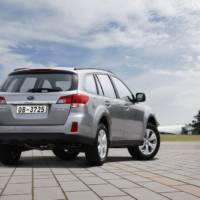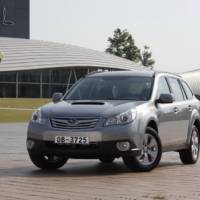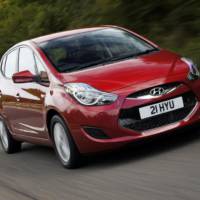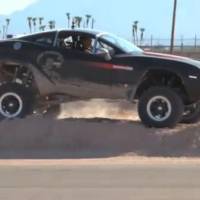The Japanese company has released details with the fourth generation, 2011 Subaru Outback which is now available with the turbocharged Boxer Diesel engine, plus it features higher quality material at the interior, and improved spaces for both passengers and luggage.
The 2011 Subaru Outback will arrive at dealerships across Ireland in December 2010, and some of its new characteristics include a longer wheelbase, plus the car is also taller and wider than the previous generation.
As we mentions, the level of comfort at the interior has been improved, and the 2.0-litre diesel engine that is now available among motorisation options, will come mated to a 6-speed manual transmission, and will deliver 150 PS and 350 Nm of torque.
Besides Subaru’s Symmetrical AWD system, the 2011 Outback will incorporate technologies like ABS, EBD, and hill-start assist as standard, plus traction control and electronic parking brake.
Other features offered as standard on the 2011 Subaru Outback 17 inch alloys wrapped in tires size 225/60 R17, a Multi-Information Display (MID) at the interior, automatic headlamps and windscreen wipers, cruise control, electric windows, a panoramic sunroof and heated leather seats.
The 2011 Subaru Outback
Subaru press release :
* All-new, fourth-generation Outback is more capable, more rewarding and more refined, both on- and off-road
* Increased cabin space and longer wheelbase improves comfort and liberates more room for occupants and luggage
* High-quality materials for the interior, and high levels of standard equipment
* Now available in Turbo charged Boxer Diesel
The fourth generation of Subaru’s ground-breaking Outback crossover vehicle arrives in showrooms in December and, thanks to a raft of changes, it’s better than ever.
Launched in Europe in 1996, the Outback pioneered the ‘Crossover’ concept, combining the comfort, interior space and superior on-road handling of a family estate, with the off-road capability and ground clearance of a sports utility vehicle. This special blend of abilities has now been further refined.
The new Outback is longer, wider and taller than the model it replaces. It is also more capable and more engaging to drive on-and off-road, and offers increased space and comfort for all occupants.
While it retains the bold, assured stance of its forebears, the New Outback boasts a distinctive new ‘face’. There’s a prominent grille which features Subaru’s now-trademark ‘wing’ motif. This bold detailing, coupled with a pair of ultra-modern, three-dimensional headlamps, gives the go-anywhere vehicle a refined yet purposeful look.
In profile, the Outback’s premium feel continues thanks to muscular, flared wheel arches, standard-fit 17-inch alloys, and a chrome-framed glass-house. Its roofline sweeps towards the rear, where it meets new body-coloured D-pillars.
On the inside, you’ll find a sophisticated interior design that perfectly complements the new Outback’s subtly muscular exterior lines. Subaru’s design team focused heavily on producing a feeling of spaciousness and quality and, thanks to several improvements such as increased seat adjustability, softer cushioning and reductions in NVH levels, the Outback’s cabin is an even more luxurious and cosseting place in which to travel.
The 1,998cc diesel, which has a six-speed manual gearbox, produces a maximum of 150ps and a top torque figure of 350Nm.
Boasting completely re-engineered suspension and a new all-steel unitary structure, the Outback’s handling and stability have been greatly improved. The presence of the Japanese firm’s highly acclaimed AWD system will also reassure buyers that it is sure-footed in all weather conditions.
STYLING AND DESIGN
More muscular styling outside, greater sophistication inside
Clearly inheriting the dynamic ‘crossover’ styling of its predecessors, but with a bolder and more distinctive silhouette, the new, fourth-generation Outback projects greater presence, both on- and off-road. The increased length, width, height and wheelbase of the vehicle provided the Subaru design team with an opportunity to give the New Outback a more muscular and expressive design.
The upright front grille, which shares the Subaru family‘wing’ motif, is placed more prominently and in a higher position, imparting a more robust, taller look to the vehicle. The distinct, three-dimensional shape of the more angular headlamps, with separate, circular fog lamps positioned at both ends of the ample bumper, conveys an increased sense of stability.
The sides of the vehicle are now a more prominent feature of the overall design, thanks to pronounced and muscular new wheel arches that hint at the New Outback’s go-anywhere, All-Wheel Drive underpinnings. The edge of the glass-house is framed by chrome-plated mouldings to reinforce a premium-quality feel.
The roofline tapers subtly to the rear, where it meets new, body-coloured D-pillars (in previous-generation Outback the D-pillars were clothed in a black-panel to visually extend the glass-house). This new design feature emphasises the evolution of the exterior design and augments a cohesive sense of solidity.
With the all New Outback, 17-inch alloy wheels are fitted as standard.
More space inside new, high-quality cabin
A sophisticated interior design harmonises with the New Outback’s subtly muscular and purposeful exterior lines, and endows the much more spacious cabin with a true sense of quality.
The design team’s key mantra was “Active and Quality Feeling”, and while exploiting the enhanced cabin space available within the new bodyshell, it concentrated on detailed attention to ensure easy-to-use functionality for the driver and passengers, and maximum comfort for extended journeys. Double-seals on all doors and windows enhance refinement by reducing the intrusion of wind noise.
The all-new, larger front seats offer excellent comfort and support, with 10-way power adjustment on the driver’s seat (including lumbar support), and four-way power adjustment on the passenger seat. The front seats feature 20% softer cushions and 10% softer backrests.
The driver’s seat benefits from more adjustability, with a 10 mm increase in fore/aft slide range, 20 mm more height movement, a 2 degree increase in cushion tilt and 20 mm lumbar adjustment. Rear-seats passengers are also offered enhanced comfort, with the 60/40 split backrest reclinable over a 20 degree range.
Facing the driver, a new instrument cluster features four dials outlined in aluminium rings, and the new three-spoke steering wheel is leather-wrapped, with integrated audio and cruise controls, and a wider range of adjustment – 40 mm for both reach and rake.
The New Outback comes with leather upholstery as standard.
COMFORT AND CONVENIENCE
Luxuriously equipped, with superior levels of comfort
The stylish, more spacious and high quality interior of the New Outback is comprehensively equipped to ensure maximum comfort and convenience for driver and passengers.
Self-levelling suspension, acknowledges the Outback’s long-standing popularity as a load-lugging workhorse or tow car. However hard the car might be working, inside the temperature can be carefully regulated by dual-zone, fully automatic air-conditioning incorporating an anti-dust filter and heating ducts to the rear passenger footwells.
A premium audio system, with a radio / CD player, six speakers (including two tweeters) and steering wheel-mounted remote controls, is standard. For the New Outback, radio reception has been significantly improved by the fitting of two high-performance antennae within the rear window glass.
The audio systems are MP3-compatible and a Bluetooth* hands-free system is fitted. Voice activation from the hands-free microphone allows users to make phone calls and operate the audio appliances.
Facing the New Outback driver, the new instrument panel integrates clarity, functionality and a visual richness in keeping with the premium character of the new model. Four dials are ringed in aluminium and feature an additional liquid crystal display panel in the centre. The dials and the display are illuminated constantly, even in daytime, to improve visibility. The dials appear white with the ignition off and turn light blue with the ignition on.
When the ignition is switched on, the gauge needles sweep to the maximum position and then quickly return to zero – heightening the excitement and anticipation of the journey to come. A glow indicator and diesel particulate filter warning light are added part of the package.
The new Multi-Information Display (MID) is positioned on the centre stack’s upper surface so that it can be viewed from all seats. The MID shows ambient temperature, fuel consumption information (instantaneous fuel efficiency, average fuel efficiency and driving range to empty), passenger seatbelt warning lights and a digital clock.
Major controls in the New Outback are laid out to minimise both the intrusion into the driver’s line of sight and the time when the driver’s hands must be off the steering wheel. Minor controls and switches are positioned to optimise ease-of-use.
The New Outback’s comprehensive list of standard equipment also extends to automatic operation of headlamps and windscreen wipers, cruise control, front and rear electric windows (with auto up/down function on the driver’s door), a glass ‘tilt-n-slide’ sunroof, and heated leather seats with memory function.
*Bluetooth is a registered trademark of Bluetooth
PRACTICALITY AND STORAGE
Additional usable space for passengers and luggage
The cabin of the New Outback is longer, wider and taller than that of its predecessor, allowing improvements to be made in comfort and practicality. The interior also demonstrates lessons learned in Subaru’s latest ‘packaging innovation’ research programme.
Larger seats are fitted to make best-use of the increased space around each occupant. The space between the front seats has increased by 30 mm and the space between the front and rear seats is increased by 62 mm. The rear seat backrest is split 60/40% and folds flat to offer the best people/cargo carrying versatility. With the rear seats upright, cargo capacity is increased by 67 litres to 526 litres, compared to the previous model.
Larger rear doors result in improved access to the rear seats, and detailed attention to the window shapes and pillar layouts ensures a greater feeling of space and light for the rear seat occupants in the New Outback.
While the width and height of the luggage bay were increased, the depth of the lip between the rear bumper and cargo was reduced slightly to ensure it is easier for users to load and unload heavy items when lifting them into the interior. The tailgate, which is 33 mm wider and 45 mm taller than before for easier access, features an electromagnetic switch for easy opening with a light touch, aided by twin supporting gas struts.
The new front seats have concave backrests to provide extra knee space for rear seat occupants. The rear seat features a folding centre armrest with twin cup holders, and the backrests can be reclined for greater comfort during long journeys. A remote one-touch mechanism conveniently located in the cargo bay side panel enables the backrests to be folded flat in one simple operation from the rear tailgate when loading long items.
Inside the New Outback designers also paid attention to create generously sized, easy-to-use storage space for smaller items – with capacity increased by 39 litres over the previous model.
The glovebox will accept 31 CDs, while the new double-decker centre console, which can accommodate 22 CDs, incorporates a 12V power supply and AUX audio input socket.
Two cup-holders are provided alongside the centre console, while a 500 ml plastic bottle can be stored in all door pockets. A 50 mm thick box of tissues can also be accommodated in the front door pockets. A central overhead console is provided for storage of sunglasses and small items.
ENGINES
2.0-litre diesel for economy and refinement
This 1,998 cc diesel is based on the Subaru ‘Boxer Diesel’ introduced in March 2008 – the world’s first horizontally-opposed diesel engine for volume-produced passenger cars. It produces a maximum output of 150 ps and maximum torque of 350 Nm between 1,800 and 2,400 rpm.
For the 2011 New Outback, this unique engine benefits from several technical refinements and enhanced environmentally-friendly features. The shape of the piston crowns has been changed for a wider, shallower design. This, in conjunction with improvements made to gas flow within the combustion chamber, have improved combustion efficiency and reduced the production of particulate matter. A ‘lift sensor’ has been added to the variable nozzle turbocharger for more precise control of the vanes.
The glow plugs have been changed from a metallic type to a ceramic type, raising the maximum operating temperature and providing better start-up at cold temperatures.
Control of the fuel injection has been optimised and the intake manifold has been redesigned in resin for improved airflow for improved torque characteristics and fuel efficiency. An added benefit of the new resin construction is the 1.5kg weight reduction over the previous aluminium version.
A single exhaust silencer has been used to optimise engine output and noise levels, while also saving weight. The addition of a vibration absorbing structure in the middle of main exhaust pipe also reduces noise levels.
The Subaru Boxer Diesel is fitted with a closed-type diesel particulate filter (DPF) that features a honeycomb shaped filter made of silicon carbide. The DPF, which is positioned low down with the turbocharger to maintain the car’s low centre of gravity, improves engine combustion efficiency and reduces particulate matter in the exhaust, further enhancing environmental friendliness.
And finally, the exhaust gas recirculator (EGR) cooler has been enlarged to improve the system’s efficiency by 12% – lowering NOx emissions to ensure that the New Outback complies with Euro 5 exhaust gas regulations.
TRANSMISSION
Smooth-shifting six-speed manual
Standard transmission for 2.0-litre diesel model is a new manual six-speed unit. This compact transmission is the same length as the previous five-speed unit and weighs just five kg more.
Improvements featured in the new transmission include a cable-type linkage and a carbon synchronizer for the first and second ratios, constantly-engaged synchromesh for reverse gear, to improve the shift feel, and optimised lubrication paths for reduced friction losses. The broader ratio coverage provided by the six-speed unit delivers better fuel economy, plus improved drivability and quietness at higher speeds.
Full-time ‘Symmetrical’ AWD – the Subaru hallmark
The New Outback incorporates the latest version of Subaru’s Symmetrical AWD (All-Wheel-Drive) system, giving the new model all the traction advantages for which the brand is famous.
This is an evolution of Subaru’s original full-time AWD system, which has a well-proven ability to provide real driving pleasure, superior driving performance and long-term reliability.
The four-wheel drive is delivered by a ‘Centre differential AWD with viscous LSD’ system. This combines a bevel-gear-type centre differential with the basic 50/50% front/rear, torque distribution and a viscous coupling limited slip differential. When a front wheel or rear wheel slips, the viscous coupling raises the torque distribution to other wheels to ensure optimum traction.
For maximum driving safety the New Outback is equipped with Subaru’s VDC system. This is an electronic stability control (ESC) programme that closely monitors vehicle behaviour and automatically corrects excessive understeer and oversteer by braking individual wheels and/or reducing engine power, ensuring that the vehicle follows the course intended by the driver for maximum safety.
RUNNING GEAR
New suspension, sub-frames and power steering
Following the strong tradition of the ‘Subaru Dynamic Chassis Control Concept’, engineers devised and developed the chassis and running gear for the New Outback to feature many new and updated components. Their aim was to create a new Subaru that was exceptionally comfortable and safe to drive for long periods, and over many years of ownership, while also guaranteeing good drivability, high performance and genuine motoring pleasure.
To reduce noise, vibrations and harshness (NVH), and to enhance ride comfort, the engine mounting structure has been entirely renewed, for the first time since the Subaru 1000 model of 1966. An all-new ‘Cradle Mount System’ was adopted where the engine and transmission are mounted on a sub-frame – rather than directly to the bodyshell. This system brings numerous benefits.
The sub-frame is attached to the bodyshell using rubber bushes, tuned to dampen different frequencies of vibrations generated by the engine, transmission and suspension. For example, the main cushion rubber uses a liquid-filled type of bush, and the engine is supported on the subframe at four widely-spread points.
In addition, the front suspension and the power steering are mounted on the sub-frame, so that potential vibrations from the road surface are not easily transferred to the bodyshell or the car’s occupants – improving ride comfort and refinement.
When combined with the AWD drivetrain, the New Outback’s 200 mm ground clearance enables the vehicle to tackle rougher ground with ease.
New front and rear suspensions
For the New Outback, Subaru has adopted a revised MacPherson strut front suspension, with the lower arm mounted on the sub-frame for greater stability. Steering response is enhanced, and quietness is increased by reducing vibrations. The thickness of the stabiliser (anti-roll) bar is increased, improving roll stiffness without requiring a change to the main spring rates. Road-holding during cornering is enhanced (thanks in part to a wider track), while smooth ride comfort is retained with extended wheel travel and optimised geometry.
At the rear, new ‘short height’ compact double-wishbone suspension is used to minimise intrusion into the cabin or cargo space. For maximum refinement, all the suspension links and the rear differential are installed on a new sub-frame. Large bushes are used between the sub-frame and the bodyshell to minimise transfer of NVH.
To achieve an ideal ride/handling balance, new low-friction type front dampers are fitted. At the rear, the Outback is fitted with specially tuned dampers with a self-leveller function to ensure consistent ride, regardless of payload.
Electric power steering for improved fuel economy
In order to improve both steering feel and fuel economy, a new rack-and-pinion steering system with electric power assistance has been adopted. The system is mounted on the front cradle frame at four points, which increases the rigidity of the steering system, and enhances its initial response to driver inputs. Compared to the outgoing Outback, a quicker ratio is used for more immediate steering response.
New electronic parking brake and hill-hold function
The all-disc braking system, with ABS and EBD (Electronic Brake-force Distribution) as standard, has a linear feel with retardation corresponding closely to applied brake pedal pressure. A redesigned master cylinder gives a 30% faster response to driver inputs on the brake pedal.
Brake Assist is also standard, developing maximum stopping power automatically when the system detects emergency application of the brakes.
For the New Outback, an innovative electronic parking brake is used. Controlled by a dashboard mounted switch, the new system does away with the traditional hand brake, freeing up cabin space and allowing a cleaner, less cluttered centre console design. If the doors are closed and the driver’s seatbelt is fastened then the parking brake will automatically release when the driver operates the accelerator pedal.
The new braking system also introduces a ‘Hill-Hold’ function. When the vehicle is stopped on a slope of 5% or more this feature will hold the vehicle on the brakes for one second after the driver removes their foot from the clutch – long enough to move it to the accelerator without rolling back; a feature that is particularly useful when towing.
Wheels and tyres
The standard wheel and tyre combination on the New Outback is a 17-inch alloy wheel with 225/60 R17 tyre.
STRUCTURE AND SAFETY
‘Circular links’ enhance strength and occupant protection
As well as ‘new-look’ styling, larger dimensions and new suspension, the New Outback has a completely reviewed and re-engineered bodyshell. The all-steel unitary structure is revised to enhance ride, handling and refinement, while also delivering the highest level of crash safety performance. The New Outback’s sister model, the New Legacy – with which it shares a chassis and body – was recently awarded a 5-Star Euro NCAP crash safety rating, confirming that Subaru’s structural and safety engineers have achieved their targets for this new model.
Newly developed, the bodyshell is both lighter and stiffer, featuring ring-shaped reinforcement frames – ‘circular links’ – joining the A, B, C and D-pillars with cross members at roof and floor level. This creates a series of ‘circular links’ which strongly protects the cabin occupants. Ultra-high-strength steel plate (980 Mpa level) is used at key portions of the bodyshell to achieve strength without adding significantly to overall weight.
By fully exploiting the structural characteristics of the newly adopted sub-frame mounting system, the front body structure is redesigned to improve the rigidity of the front suspension installation and to enhance impact resistance as well as steering response. These improvements, and reinforcement of the engine bay bulkhead and toe board areas, were accomplished while also saving 6 kg from the front body panels.
The rear floor structure has also been optimised to accommodate the new sub-frame and to reduce weight while increasing rigidity, further improving rear suspension characteristics and vehicle drivability.
Delivering superior crash safety protection
Using the advanced ring-shaped reinforcements throughout the New Outback bodyshell enhances collision safety and resistance to impacts from all directions. In addition, the newly adopted sub-frame mounting system contributes to an enlarged front-end crush zone, further improving occupant protection.
During a front-end collision, the new front sub-frame deforms in a controlled manner and pushes the power unit to the rear and downwards. As a result, the rearward movement of such a large mass dissipates impact energy and assists the efficient absorption of collision energy by the main body structure.
To enhance side-impact protection, ultra-high-strength steel plate (980 Mpa level) is used for the B-pillar and side sill structures to improve the local cabin area rigidity. In addition, two door impact beams are placed within each front and rear door. By optimally positioning the beams in relation to the door’s internal structure, a sufficient crush space is ensured to minimise intrusion. Furthermore, a ‘door catcher’ is fitted to prevent the bottom of the rear door from deforming into the cabin – particularly in rear impacts.
Despite the relatively short rear overhang, the New Outback’s structure is optimised so that rear impact energy is efficiently absorbed by controlled and gradual crushing of the rear sub-frames.
‘Passive’ safety advances that also benefit pedestrians
While a robust structure can form the foundation for a truly safe car, Subaru has also ensured that the New Outback is comprehensively kitted out with a full range of both ‘passive’ and ‘active’ safety equipment – as the best way to prevent occupant injury is to overcome the hazards of daily motoring and avoid any accident in the first place.
The new front seats have significantly-stiffer frames and inner-structures to provide protection against whiplash injuries without having to fit ‘active’ head restraints. New-design, energy-absorbing head restraints offer greater protection by reducing head impact forces.
Front, side and curtain airbags are fitted as standard. The side and curtain airbags are enlarged for enhanced performance, and the airbag impact sensors have been upgraded to improve responses.
To protect the driver’s knee and lower leg, the steering column’s structure has been redesigned with an impact-absorption space, and a knee protector is fitted. All the foot pedals and the driver’s footrest have a collapsible function (above a pre-set g-force) to reduce the likelihood of foot injuries.
The issue of pedestrian protection has also been addressed. New, impact-absorbing materials and an optimised structure around the front bumper have made it possible for the New Outback to clear the next-generation European pedestrian protection standards, which are the most stringent in the world.
Although steel is used for the hood (to maximise protection of the car’s occupants), the impact-absorbing space beneath the hood and above the low boxer engine is enlarged, and the structure is improved around the body cowl to reduce possible injury to a pedestrian.
EQUIPMENT
Standard Equipment on 2011 New Outback Diesel
Exterior
Body-coloured bumpers
Body-coloured door mirrors housings
Body-coloured door handles
Electric folding, heated door mirrors with LED repeaters
HID head lamps with power washers and automatic self-leveling
Front fog lights
UV protected front, side and rear glass
Intermittent rear wash/wipe
Roof spoiler
17-inch alloy wheels with 225/60 R17 tyres
Powered glass tilt-and-slide sunroof with interior sunshade
Interior
Welcome lights front and rear
Leather upholstery and trim
10-way electrically adjustable driver’s seat with memory
Tilt and telescopic steering wheel adjustment
Steering wheel mounted audio and cruise controls
Leather-wrapped steering and gear selector
Adjustable lumbar support
Driver’s seatback storage pocket
Heated front seats
Driver and passenger illuminated vanity mirrors
Front map reading lights and cascade lighting
Electric windows front and rear
Adjustable dashboard illumination
Multi Information Display
Multi-function centre console with 12v power outlet
Front and rear cup-holders
60/40 spilt rear seat with centre armrest
Retractable luggage cover
Comfort and Convenience
Automatic dusk-sensing head lamps
Automatic rain-sensing wipers
Dual-zone automatic air-conditioning
Cruise control
Bluetooth connectivity
Eco driving ‘change-up’ indicator
Gear-in-use indicator
Six-CD tuner with RDS and six speakers
Speed-adjusting automatic volume control
AUX input socket in centre console
Audible headlights on reminder
Remote fuel flap release
Front passenger seatback storage pocket
Safety
Front, front side and curtain air bags
Vehicle Dynamics Control stability system
Self levelling rear suspension
Traction Control
ABS, EBD and EBA braking systems
AWD full-time Symmetrical All-Wheel drive system
Electronic push/pull handbrake
Hill start assist linked to VDC system
Security
Remote central locking with deadlocks
High security integrated audio system
Rolling code ECU immobiliser
TECHNICAL SPECIFICATIONS
New Subaru Outback
Engines
2.0-litre / 150 PS Diesel
Name Boxer Diesel
Type DOHC, horizontally opposed ‘flat four’, with VGT
Capacity 2.0-litres, 1,998 cc
Bore & Stroke 86.0 x 86.0 mm
Compression ratio 16.0:1
Max power 150 PS (110 kW) @ 3,600 rpm
Max torque 350 Nm (258.2 lbf.ft) @ 1,800-2.400 rpm
Valves 16 (4-per-cylinder)
Fuel system CRDi, common-rail, high pressure, direct injection
Turbo system Variable geometry turbocharger (VGT)
Construction Aluminium cylinder block and heads
Emissions class Euro Stage 5
Transmission
2.0D
Manual 6-sp
Gear Ratios
2.0D MT
1 3.454
2 1.750
3 1.062
4 0.785
5 0.634
6 0.557
Reverse 3.636
Final Drive 1 4.444
Drivetrain
2.0D AWD with centre differential coupled to viscous LSD
Suspension and Damping
Front Fully independent by subframe-mounted MacPherson struts, with coil springs and gas-filled shock absorbers. Anti-roll stabiliser bar.
Rear Fully independent by subframe-mounted Double Wishbones, coil springs and gas-filled shock absorbers, with self-levelling system.
Steering
Type Electric power-assisted rack & pinion
Wheel 375 mm leather wrapped
Gearing 3.1 turns lock-to-lock
Turning circle 11.0 metres
Brakes 2.0D
Power 229
Front 294×24
Rear 286×10
ABS 4-Channel anti-lock system with EBD
BAS Boosts braking power to maximum during emergency stops
Wheels and Tyres
Standard Alloy 17 in x 7.0J 225/60 R17 tyres
Spare Tyre mobility kit
Dimensions (mm)
Exterior
Overall length 4775 Overall width* 1820 / 2052
Overall height 1605** Wheelbase 2745
Front track 1540 Rear track 1540
Front overhang 960 Rear overhang 1070
Ground clearance 200
Approach angle 18.6 deg Departure angle 23.0 deg
*excluding / including door mirrors
**including roof rails
Interior
Front Rear
Headroom 1024 951
Legroom 1091 960
Shoulder room 1430 1426
Hip room 1384 1370
Capacities (all models)
Fuel tank 65 litres
Luggage (VDA) 526 litres behind 2nd row seats
1677 litres behind 1st row seats
Weights (kg)
2.0D MT
Curb weight 1573
Gross weight 2085
Towing (max) kg* 750
kg** 1700
*unbraked trailer / ** braked trailer
Performance
2.0D MT
Top speed / Kph 201
0-to-100 Kph / sec 9.6
Fuel Economy (mpg)
2.0D MT
Combined cycle 6.1 Lit/100Km
CO2 g/km 167
Generous Warranty
All models marketed by Subaru Ireland come with the reassurance of a three year or 160,000 kilometres warranty, plus twelve year anti-corrosion cover and three year paintwork warranty.
This is in addition to three year’s membership of Subaru Assist – a comprehensive home and roadside repair and recovery package throughout Ireland and Europe administered by Mapfre Asistencia.
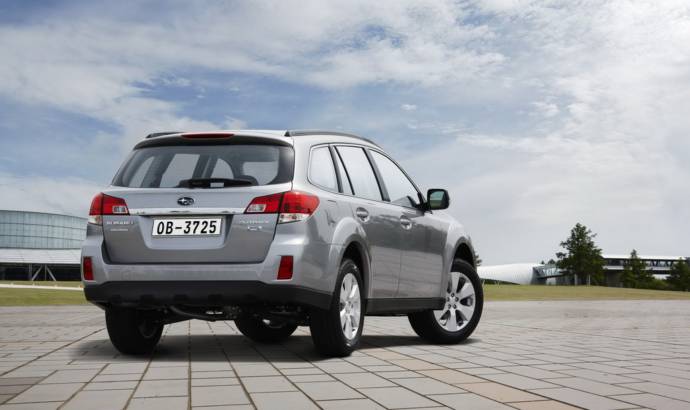
28 Oct 2010
0

